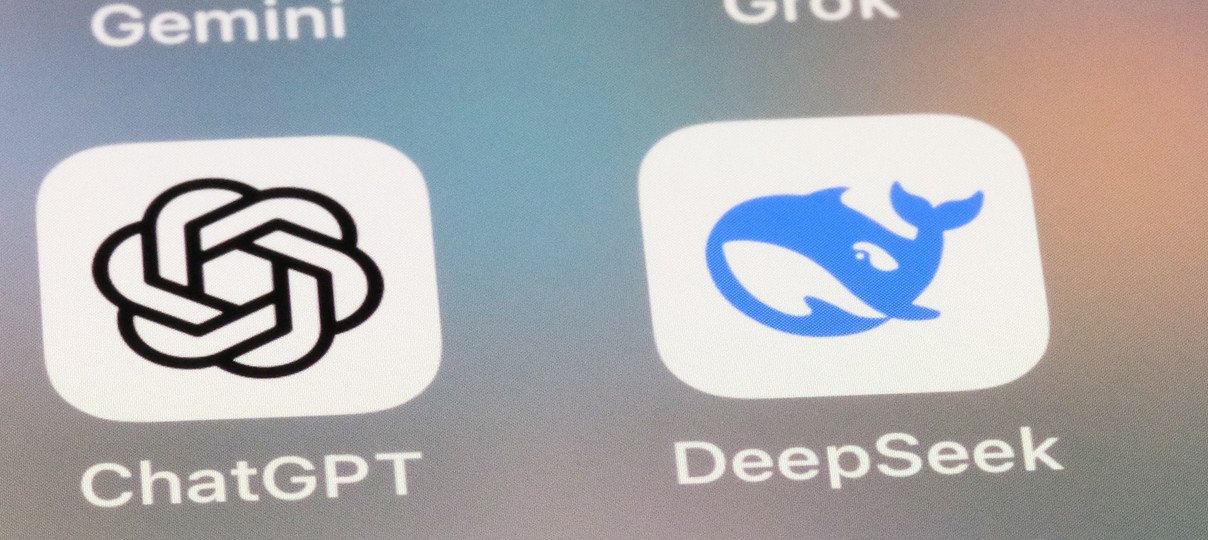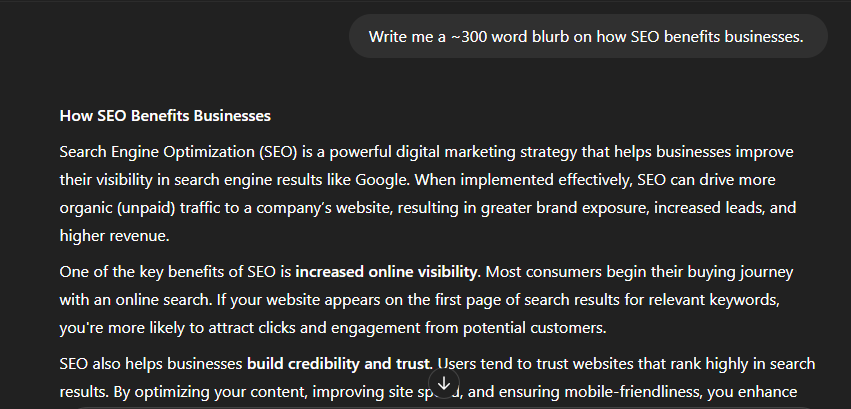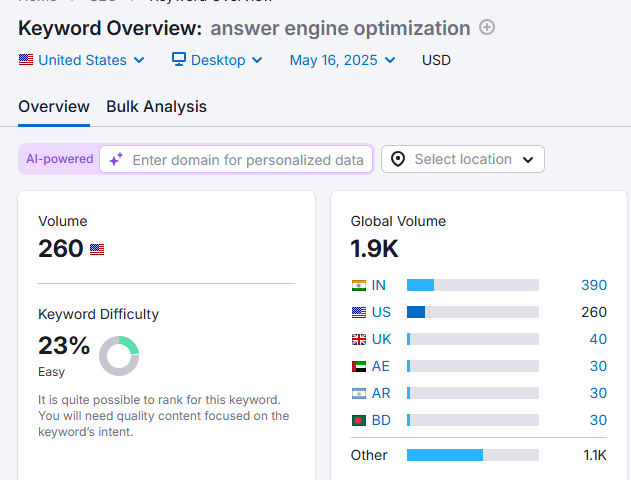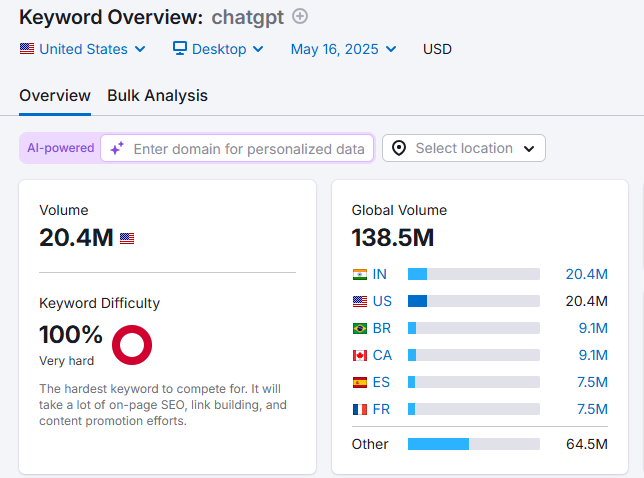Answer Engine Optimization: A High-Level Guide

For the longest time, search engine optimization, or SEO, has reigned supreme in the world of digital marketing. Most digital marketers agree that while SEO takes a long time and is very resource-intensive, it delivers the highest close rate, the highest ROI, and generates the biggest increases in brand visibility, awareness, perception, and trust.
But now, with the advent of Google’s SGE, or Search Generative Experience, and AI-powered engines like ChatGPT, there’s a (relatively) new kid on the block.
It’s called AEO, or answer engine optimization, and while fundamentally very similar to SEO, it still varies slightly. Here’s your primer, as well as some pointers for how to optimize a website or its contents for AEO.
What Is Answer Engine Optimization? (AEO)

AEO stands for answer engine optimization, and it refers to the process of optimizing a piece of content with the end result that it be highlighted by or featured in a generative model – such as a rich or featured snippet, Google’s AI overview or SGE, or end up as a regurgitated output through an AI model like OpenAI’s ChatGPT.
For the most part, it refers to getting a website or a piece of content to end up as an output to an AI prompt, since AI models are sometimes referred to as “answer engines” hence the name “AEO.”
What’s the Difference Between AEO and SEO?
While AEO is not strictly speaking the same thing as SEO, there is a great deal of crossover, with most digital marketing experts either suspecting or outright recognizing that answer engines use the same ranking signals as search engines.
The difference is, however, quite nuanced.
To keep this all relatable, we’ll use a search engine as an example. SEO will get a website or a page to show up in the search results. AEO will get it to show up in the AI overview or, to a lesser degree, in the People Also Ask section of the search results, even though that isn’t strictly speaking an answer engine.
So, in a nutshell, the chief difference between SEO and AEO is the length of the query. A single keyword is not, in the truest semantic sense of the word, a query. I mean, it is literally a search query but it is not linguistically a query because it is not a question.
You could type “SEO” into Google and you will get search results. You may also get an AI overview, but to get a good one, you will need to embed that keyword into a broader search query – that is, a whole question.
Therefore, the main difference between AEO and SEO has to do with the length and completeness of the search query. SEO deals with both short and long-tail queries, and AEO almost exclusively with long tail, very long tail queries. Most AEO relates to fully formed, grammatically complete interrogative statements.
Therefore, while both SEO and AEO utilize the same ranking signals, the rankings signals that AEO uses are mostly with respect to keyword use and the structure of the content being crawled insomuch as it relates to the question being asked. For the most part, other conventional SEO ranking signals, like backlink profile and site speed, do not factor into AEO (though they do indirectly).
Also, because of the distinction I just drew, it is more accurate to consider AEO a subset of SEO than a completely distinct marketing strategy or channel. If you do SEO the right way and make it all about content, you’re going to get AEO results. It’s ultimately as simple as that.
How to Optimize for AEO

Good news: if you know how to optimize for SEO, at least on a functional level, then you already know what to do to optimize for AEO, with a few nuanced distinctions.
You’ve heard SEO copywriters like myself talk about how you need to focus on quality content, and that is no different here. It’s just more important here.
So here are the 6 main things you need to do to optimize for AEO.
- Understand search intent and target the right keywords (queries)
It all starts with what people are searching for, as well as why. While keywords are important, what you need to aim for in AEO is a fully-formed question (or an answer to one) that includes the keyword. Not just a keyword itself.
Also critical is intent. If you want to show up in the generative results of an answer engine, you need to know the reason people are searching for and what the answer is they’re looking for as well.
So, you can optimize for the keyword “SEO” and you might show up in the search results (good luck with that, through, last I checked that keyword had a difficulty score of 100%) or you can optimize for “How SEO services benefit small businesses” and aim to provide a succinct answer to that – which brings up the next vital element of AEO optimization.
- Target specific questions
I’ll just shoot straight. Getting a good AEO result is hard enough. You will never get there if you don’t target specific questions people are searching. And when I say specific – I mean literatim, word for word.
If you have access to a tool like SEMRush, you can use their Keyword Overview tool to look at actual questions that people are searching for, along with volumes and difficulty scores. You don’t need to come up with the questions; just enter a keyword.
Alternatively, you can just use what’s free – Google. Type a keyword in and see what shows up in the People Also Ask section. Google gets those questions from real queries people are searching for. These are the questions you should answer. Another good free tool is Answer the Public.
- Provide clear, concise answers
Once you have your questions all in a row, then you need to provide clear, concise answers that are accurate and insightful. Forget what you’ve read about keyword and length requirements. The shorter and more concise the better for AEO, especially if you can still provide a complete answer.
Also, if you’re answering the question succinctly, you’re going to be including the keyword in your answer to the query anyway, so don’t worry about that.
Using novel information is acceptable, as long as it is accurate. This is because as people find your information and circulate it (either by spending time on your page or linking to your website) both search engines and answer engines will see it as an authority and that will be all the backup they need to keep your answer showing up in their results.
- Use structured data
I’m including this only because as a technical ranking factor, it can slightly improve your odds of your copy being pulled for a featured snippet or displayed as a ChatGPT result. For instance, if you implement Schema Markup, you’ll have a slightly better chance of getting those AEO results. However, the first three portions of this how-to section are more important. You need to answer questions before you’ll show up, period. Structured data is an assist, not a solution.
- Optimize for voice search
Good news: optimizing for voice search really only means one thing (at least at this point). Structure your copy as conversational, full thoughts. Don’t write using fragments, type everything out as if it were for a formal paper submission, or at least as part of a conversation with another person. The more natural the language sounds, the better it will perform in the voice search results, and the better it will adapt to engines like ChatGPT, into which people enter intact, whole sentences and questions, rather than single keywords or short-tail phrases.
- Use GSC
Google Search Console is a gold mine of good information that can help you improve the performance of existing web pages while also furnishing you with insights for new pages and copy that will perform independently.
When you’re looking at the performance of a given web page, take a look at the impressions to see what long-tail queries that page showed up for. Some of these will likely be full questions that triggered an impression. Sometimes those questions will be relevant, and sometimes they won’t be.
In those instances in which your web page shows up for a question that doesn’t seem that aligned with the page, it means there’s an opportunity for you to answer that question succinctly. Go back in and update that page so that it offers a more succinct answer to the query for which it generated an impression.
Here’s a real life example:

That’s a snapshot of the company’s GSC for an article I wrote on how to show up in the AI overview. Shown above are a few of the queries for which the post generated impressions but no clicks. The one highlighted in red is a great example of an opportunity because, while I did indirectly answer that question in the article, I did not include the question or an answer for it word for word.
Yet, as you can see, people are searching for it – it generated 152 impressions in just the last three months. There’s a disconnect between impressions and clicks, which I may be able to rectify by editing the article so that question, and a direct answer, show up in it.
This is a great trick for finding long-tail queries as well as opportunities for improving your existing copy, as well as new ideas for upcoming content.
Additional AEO note: I would also like to take this point to note that AI models apparently can’t “see” Javascript, so one more pointer for AI optimization is that you need to have HTML code on your website.
Using AEO and SEO Together
As I clarified just above in this article, AEO and SEO are not entirely distinct, and AEO can in fact be categorized as a subset of SEO.
Therefore, all the best practices that benefit SEO will also in practice benefit AEO efforts, too. For instance, as all the SEO experts have been saying for years, you want a fast website with no glitches that offers a high-quality UX.
A website with plenty of optimized onsite copy and a healthy backlink profile is also going to be awarded overall higher organic rankings and probably a higher domain authority score than one that hasn’t been holistically optimized, and Google is more likely (taking all into consideration) to scrape a web page for a generative result if it’s been optimized heel to toe.
The key takeaway is that all SEO best practices remain in force, with the added effect that to optimize for AEO you need to go a bit further.
For instance, a category or product page is optimized for SEO if it is fast, secure, issue free, and if all the page level factors (image file size, alt text, page title text, meta data field, etc.) have been optimized.
However, it can only truly be said to be optimized for AEO if there are specific answers in the page copy (or other data fields) to equally specific queries.
So, let’s say that this same web page is optimized for SEO but also contains a FAQs section with several long-tail queries along with accurate, complete, insightful answers – then it is also optimized for AEO.
How Does ChatGPT SEO Work?
ChataGPT SEO is the term that digital marketers and other savants have been throwing around, which refers to the process of optimizing a web page, or a listing, or a post, or some other piece of digitally published content for ChatGPT’s algorithm.
This should come as no secret to my candid audience, but ChatGPT’s primary source of information is the internet, and since it is able to scrape the internet, the main ranking signals that ChatGPT uses to generate outputs are therefore indirectly also what Google uses.
Are there other sources on the internet besides Google? Of course, but since Google is the 500 pound gorilla in the room, invariably Google is going to be a big force to reckon with here.
Now, I am not suggesting that the two algorithms are the same. ChatGPT’s large language model is inherently distinct from Google’s and I will not in any way play expert here. I will only admit that they are different and while I am familiar with what makes Google tick, ChatGPT is still a bit alien to me.
With that said, since ChatGPT is so heavily reliant on what’s already ranking in the search engines for information, regardless of the fact that its algorithm may be different from Google’s, what you need to do to optimize for ChatGPT is effectively the same as what you need to do for Google.
Does ChatGPT Generated Text Hurt Your SEO?
This is one of the most common questions out there relative to ChatGPT and ChatGPT SEO, so, rather than saying yes or no, let me provide an illustration.
Let’s try something specific.

Guys, this is so bad, like dangerously bad. These two cartridges are not the same, though they are similar. ChatGPT got that right. What it got wrong is that it said they can be used interchangeably. They cannot. I’m not getting into why. Do your own research if you don’t believe me.
Now let’s try something else:

I read the pointers and they’re all pretty good. You can see some of them in that abbreviated screencapture. But here’s one potential issue. I ran the full output (273 words, at least Chat got the length request right) and here’s what ZeroGPT told me:

Slight problem, for sure. Seriously, couldn’t it even give me 98% or something? 100% AI generated is not a good look, people.
Besides, let’s just do a thought experiment. If you’re looking for how to optimize for AEO and use AI to do it, you’re just creating an echo chamber, with zero thought involved. It makes no sense and at a certain point will break down.
More importantly, if Google and ChatGPT actually introduce AI-detection capabilities into their algorithms and flag content that they suspect is AI-generated, then that should be your answer: yes, ChatGPT generated text will hurt your SEO, and by extension, your AEO.
There are two reasons for this. One is that it’s easy to flag the generated output as AI. The other (and more important of the two) is that there is a serious risk that the generated output will be patently false, and sometimes dangerously false, as illustrated pointedly in the first image above.
By the way, the Google AI overview is not much better. In fact, in a lot of ways it’s worse. Not that you could use the AI overview output to generate text, but I would caution you against using it as a primary source for literally anything.
For the purpose of illustration, I tried to find some bad AI overviews but ran into some trouble. I also just noticed that it was disabled for a few of my attempts to find some really bad answers. I’ll save you the trouble of looking yourself; here are a few of the worst ones that have been published since Google rolled out the AI overview.
Is AEO Replacing SEO?
Well, AEO is certainly changing SEO, that’s a fact. As more and more people enter long-tail queries expecting a single precise answer rather than a list of results, AEO will start to take center stage. But at the same time, since AEO is just a facet of SEO, it can’t really be said to be replacing it.
Besides, we could also just look at the numbers. Apparently, as of March 2025, there are over 16 billion Google searches per day. That’s more than double the total global population. It’s also almost doubled (so far) since 2024. If SEO were truly being replaced, wouldn’t searches have to be decreasing? (Spoiler: Yes.)
I had a little more trouble finding figures for ChatGPT usage, but according to at least one source, it gets some pretty good traffic. Somewhere around 38 million outputs per day – a lot, but way, way lower what Google gets.
Alright, that paints a picture of the health of search engine use. What about interest in AEO as a topic?

Well then, SEMRush, that’s somewhat less than a billion, let alone 16 billion, per day.
Surely interest in ChatGPT SEO is much higher?

Apparently not. Higher but not monumentally so. What about regular SEO?

Plenty of interest there. How about ChatGPT in general?

That’s a rosier picture. There’s a lot of interest in ChatGPT, but even with that kind of volume, it’s important to remember that ChatGPT’s usership is still dwarfed by Google’s (with ~38 million outputs per day to more than 16 billion searches per day, Google outputs outpace ChatGPT by a factor of over 400).
As you can see, interest in SEO as a concept is still healthy. That’s apparent from search volume alone. What will happen in ten years or even next month is your guess as well as mine, but it doesn’t look like AEO is replacing SEO or even that ChatGPT is replacing Google. It could happen, but for now they’re both still driving a lot of traffic, though the nod definitely goes to search engines.
What I can say is this. Continue doing what you’re doing with SEO and when it comes to content marketing, hammer home on those long-tail queries. If you have customers asking you questions about products, how to use them, how to care for them, or what the specifics are, answer those questions fully in your materials, on your product pages, in your newsletter and on your blog.
By doing so, you will be optimizing for AEO, and will help drive visibility not only through search engines but also potentially in the long run through AI models.